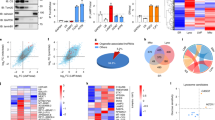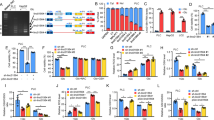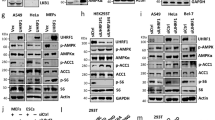Abstract
Long non-coding RNAs (lncRNAs) have emerged as critical regulators in various cellular processes. However, the potential involvement of lncRNAs in kinase signalling remains largely unknown. AMP-activated protein kinase (AMPK) acts as a critical sensor of cellular energy status. Here we show that the lncRNA NBR2 (neighbour of BRCA1 gene 2) is induced by the LKB1–AMPK pathway under energy stress. On energy stress, NBR2 in turn interacts with AMPK and promotes AMPK kinase activity, thus forming a feed-forward loop to potentiate AMPK activation during energy stress. Depletion of NBR2 attenuates energy-stress-induced AMPK activation, resulting in unchecked cell cycling, altered apoptosis/autophagy response, and increased tumour development in vivo. NBR2 is downregulated and its low expression correlates with poor clinical outcomes in some human cancers. Together, the results of our study uncover a mechanism coupling lncRNAs with metabolic stress response, and provides a broad framework to understand further the regulation of kinase signalling by lncRNAs.
This is a preview of subscription content, access via your institution
Access options
Subscribe to this journal
Receive 12 print issues and online access
$209.00 per year
only $17.42 per issue
Buy this article
- Purchase on Springer Link
- Instant access to full article PDF
Prices may be subject to local taxes which are calculated during checkout







Similar content being viewed by others
References
Ulitsky, I. & Bartel, D. P. lincRNAs: genomics, evolution, and mechanisms. Cell 154, 26–46 (2013).
EP Consortium An integrated encyclopedia of DNA elements in the human genome. Nature 489, 57–74 (2012).
Batista, P. J. & Chang, H. Y. Long noncoding RNAs: cellular address codes in development and disease. Cell 152, 1298–1307 (2013).
Gupta, R. A. et al. Long non-coding RNA HOTAIR reprograms chromatin state to promote cancer metastasis. Nature 464, 1071–1076 (2010).
Huarte, M. et al. A large intergenic noncoding RNA induced by p53 mediates global gene repression in the p53 response. Cell 142, 409–419 (2010).
Prensner, J. R. et al. Transcriptome sequencing across a prostate cancer cohort identifies PCAT-1, an unannotated lincRNA implicated in disease progression. Nat. Biotechnol. 29, 742–749 (2011).
Engreitz, J. M. et al. The Xist lncRNA exploits three-dimensional genome architecture to spread across the X chromosome. Science 341, 1237973 (2013).
Rinn, J. L. et al. Functional demarcation of active and silent chromatin domains in human HOX loci by noncoding RNAs. Cell 129, 1311–1323 (2007).
Wang, K. C. et al. A long noncoding RNA maintains active chromatin to coordinate homeotic gene expression. Nature 472, 120–124 (2011).
Guttman, M. & Rinn, J. L. Modular regulatory principles of large non-coding RNAs. Nature 482, 339–346 (2012).
van Heesch, S. et al. Extensive localization of long noncoding RNAs to the cytosol and mono- and polyribosomal complexes. Genome Biol. 15, R6 (2014).
Hardie, D. G., Ross, F. A. & Hawley, S. A. AMPK: a nutrient and energy sensor that maintains energy homeostasis. Nat. Rev. Mol. Cell Biol. 13, 251–262 (2012).
Hawley, S. A. et al. Complexes between the LKB1 tumor suppressor, STRAD α/β and MO25 α/β are upstream kinases in the AMP-activated protein kinase cascade. J. Biol. 2, 28 (2003).
Woods, A. et al. LKB1 is the upstream kinase in the AMP-activated protein kinase cascade. Curr. Biol. 13, 2004–2008 (2003).
Shaw, R. J. et al. The tumor suppressor LKB1 kinase directly activates AMP-activated kinase and regulates apoptosis in response to energy stress. Proc. Natl Acad. Sci. USA 101, 3329–3335 (2004).
Hardie, D. G., Schaffer, B. E. & Brunet, A. AMPK: an energy-sensing pathway with multiple inputs and outputs. Trends Cell Biol. 26, 190–201 (2015).
Laplante, M. & Sabatini, D. M. mTOR signaling in growth control and disease. Cell 149, 274–293 (2012).
Gwinn, D. M. et al. AMPK phosphorylation of raptor mediates a metabolic checkpoint. Mol. Cell 30, 214–226 (2008).
Inoki, K., Zhu, T. & Guan, K. L. TSC2 mediates cellular energy response to control cell growth and survival. Cell 115, 577–590 (2003).
Egan, D. F. et al. Phosphorylation of ULK1 (hATG1) by AMP-activated protein kinase connects energy sensing to mitophagy. Science 331, 456–461 (2011).
Kim, J., Kundu, M., Viollet, B. & Guan, K. L. AMPK and mTOR regulate autophagy through direct phosphorylation of Ulk1. Nat. Cell Biol. 13, 132–141 (2011).
Shackelford, D. B. & Shaw, R. J. The LKB1-AMPK pathway: metabolism and growth control in tumour suppression. Nat. Rev. Cancer 9, 563–575 (2009).
Huang, J. & Manning, B. D. The TSC1-TSC2 complex: a molecular switchboard controlling cell growth. Biochem. J. 412, 179–190 (2008).
Hezel, A. F. & Bardeesy, N. LKB1; linking cell structure and tumor suppression. Oncogene 27, 6908–6919 (2008).
Alessi, D. R., Sakamoto, K. & Bayascas, J. R. LKB1-dependent signaling pathways. Annu. Rev. Biochem. 75, 137–163 (2006).
Faubert, B. et al. AMPK is a negative regulator of the Warburg effect and suppresses tumor growth in vivo. Cell Metab. 17, 113–124 (2013).
Xu, C. F. et al. Isolation and characterisation of the NBR2 gene which lies head to head with the human BRCA1 gene. Hum. Mol. Genet. 6, 1057–1062 (1997).
Sim, A. T. & Hardie, D. G. The low activity of acetyl-CoA carboxylase in basal and glucagon-stimulated hepatocytes is due to phosphorylation by the AMP-activated protein kinase and not cyclic AMP-dependent protein kinase. FEBS Lett. 233, 294–298 (1988).
Bungard, D. et al. Signaling kinase AMPK activates stress-promoted transcription via histone H2B phosphorylation. Science 329, 1201–1205 (2010).
Corradetti, M. N., Inoki, K., Bardeesy, N., DePinho, R. A. & Guan, K. L. Regulation of the TSC pathway by LKB1: evidence of a molecular link between tuberous sclerosis complex and Peutz-Jeghers syndrome. Genes Dev. 18, 1533–1538 (2004).
Hardie, D. G. AMPK-sensing energy while talking to other signaling pathways. Cell Metab. 20, 939–952 (2014).
Gad, S. et al. Characterisation of a 161 kb deletion extending from the NBR1 to the BRCA1 genes in a French breast-ovarian cancer family. Hum. Mutat. 21, 654 (2003).
Jin, H. et al. Structural evolution of the BRCA1 genomic region in primates. Genomics 84, 1071–1082 (2004).
Pandey, R. R. et al. Kcnq1ot1 antisense noncoding RNA mediates lineage-specific transcriptional silencing through chromatin-level regulation. Mol. Cell 32, 232–246 (2008).
Feng, J. et al. The Evf-2 noncoding RNA is transcribed from the Dlx-5/6 ultraconserved region and functions as a Dlx-2 transcriptional coactivator. Genes Dev. 20, 1470–1484 (2006).
Lee, S. W. et al. Skp2-dependent ubiquitination and activation of LKB1 is essential for cancer cell survival under energy stress. Mol. Cell 57, 1022–1033 (2015).
Lin, A. et al. The FoxO-BNIP3 axis exerts a unique regulation of mTORC1 and cell survival under energy stress. Oncogene 33, 3183–3194 (2014).
Gan, B. et al. Lkb1 regulates quiescence and metabolic homeostasis of haematopoietic stem cells. Nature 468, 701–704 (2010).
Gan, B. et al. mTORC1-dependent and -independent regulation of stem cell renewal, differentiation, and mobilization. Proc. Natl Acad. Sci. USA 105, 19384–19389 (2008).
Gan, B. et al. FoxOs enforce a progression checkpoint to constrain mTORC1-activated renal tumorigenesis. Cancer Cell 18, 472–484 (2010).
Lin, A. et al. FoxO transcription factors promote AKT Ser473 phosphorylation and renal tumor growth in response to pharmacological inhibition of the PI3K-AKT pathway. Cancer Res. 74, 1682–1693 (2014).
Gyorffy, B., Surowiak, P., Budczies, J. & Lanczky, A. Online survival analysis software to assess the prognostic value of biomarkers using transcriptomic data in non-small-cell lung cancer. PLoS ONE 8, e82241 (2013).
Gyorffy, B. et al. An online survival analysis tool to rapidly assess the effect of 22,277 genes on breast cancer prognosis using microarray data of 1,809 patients. Breast Cancer Res. Treat. 123, 725–731 (2010).
Acknowledgements
We thank all members of the Gan laboratory for their advice and technical assistance. This research has been supported by grants from MD Anderson Cancer Center, US Department of Defense (TS093049), Cancer Prevention & Research Institute of Texas (RP130020), National Institutes of Health (CA181196 and CA190370), Ellison Medical Foundation (AG-NS-0973-13), and Gabrielle’s Angel Foundation for Cancer Research (to B.G.). B.G. is a Kimmel Scholar and an Ellison Medical Foundation New Scholar. H.Liang is supported by the National Institutes of Health (CA143883, CA175486); the R. Lee Clark Fellow Award from The Jeanne F. Shelby Scholarship Fund; a grant from the Cancer Prevention and Research Institute of Texas (RP140462); and the Mary K. Chapman Foundation and the Lorraine Dell Program in Bioinformatics for Personalization of Cancer Medicine. L.H. is supported by Cancer Prevention & Research Institute of Texas (RR150085). H.-K.L. is supported by the National Institutes of Health (CA182424 and CA193813). B.G., J.C., J.W. and H.Liang are members of the MD Anderson Cancer Center, and are supported by the National Institutes of Health Core Grant CA016672.
Author information
Authors and Affiliations
Contributions
Z.-D.X. initiated the project and identified NBR2 as an energy-stress-induced lncRNA. X.L. performed most of the experiments with assistance from Z.-D.X., H.Lee, and L.Z. J.Z. and J.W. analysed RNA-seq data set. L.H. and H.Liang conducted computational analysis on NBR2 expression and status in human cancers. W.W., J.C., S.-W.L. and H.-K.L. provided reagents. B.G. supervised the study. X.L., Z.-D.X. and B.G. designed the experiments and wrote the manuscript. All authors commented on the manuscript.
Corresponding author
Ethics declarations
Competing interests
The authors declare no competing financial interests.
Integrated supplementary information
Supplementary Figure 1 The schematic diagram of the genomic region of human BRCA1 and NBR2 genes with different splicing isoforms.
Arrows represent the direction of transcription.
Supplementary Figure 2 AMPK inactivation by compound C or AMPKα siRNA treatment.
(a) MDA-MB-231 cells were treated with 20 μM Compound C in 25 or 0 mM glucose-containing medium for 24 hours, and then subjected to Western blotting analysis to measure AMPK activation. (b) MDA-MB-231 cells transfected with AMPKα or control (Ctrl) siRNA were cultured in 25 or 0 mM glucose-containing medium for 24 hours, and then subjected to Western blotting analysis to measure AMPK activation. Unprocessed original scans of blots are shown in Supplemental Fig. 8.
Supplementary Figure 3 NBR2 knockdown affects autophagy and cell proliferation in response to energy stress.
(a) The effect of NBR2 deficiency on GFP-LC3 puncta formation. 786-O cells infected with either control shRNA or NBR2 shRNA were transfected with GFP-LC3 plasmid, and then cultured in 25 or 0 mM glucose-containing medium for 18 hours. GFP-LC3 punctate foci were then detected using fluorescence microscopy. (Scale bars, 20 μm) (b) The effect of NBR2 deficiency on ULK1 phosphorylation and p62 degradation in response to glucose starvation. MDA-MB-231 cells infected with either control shRNA or NBR2 shRNA were cultured in 25 or 0 mM glucose-containing medium for 12 h. Cell lysates were then analyzed by Western blotting. (c,d) Cells infected with either control shRNA or NBR2 shRNA were cultured in 1 mM glucose-containing medium for different days as indicated, and then subjected to cell proliferation analysis (Mean ± s.d., n = 3 biologically independent extracts, two-tailed paired Student’s t-test). Source data for c,d can be found in Supplementary Table 1. Unprocessed original scans of blots are shown in Supplemental Fig. 8.
Supplementary Figure 4 Mechanistic studies of NBR2 regulation of AMPK.
(a) Protein lysates were prepared from HEK293T cells transfected with empty vector (EV), NBR2 full length (FL), T4, or T5 fragment expression vectors, and analyzed by Western blotting as indicated. (b) Protein lysates prepared from UMRC2 cells stably expressing EV or NBR2 #1 expression vectors were immunoprecipitated by IgG, LKB1 or Folliculin antibodies, and then were analyzed by Western blotting as indicated. Aliquots of the protein lysates (input) were also analyzed directly. (c) 786-O cells infected with either control shRNA or NBR2 shRNA were cultured in medium containing 0 or 25 mM glucose for 12 hours. Protein lysates were prepared and immunoprecipitated by IgG or LKB1 antibodies, and then were analyzed by Western blotting as indicated. Aliquots of the protein lysates (input) were also analyzed directly. (d) Empty vector (EV) or LKB1-infected Hela cells were transfected with EV or NBR2 #1 expression vectors. Protein lysates were prepared and analyzed by Western blotting as indicated. Unprocessed original scans of blots are shown in Supplemental Fig. 8.
Supplementary Figure 5 The working model of the reciprocal regulation between NBR2 and AMPK under energy stress, and its relevance to cancer development.
See discussion for detailed description.
Supplementary Figure 6 NBR2 deficiency affects AMPK activation under long periods of energy stress.
(a) MDA-MB-231 cells infected with either control shRNA or NBR2 shRNA were cultured in 0 mM glucose-containing medium for different hours, and protein lysates were prepared and analyzed by Western blotting. (b) MDA-MB-231 cells were cultured in 0 mM glucose-containing medium for different hours, and then subjected to real-time PCR analysis to measure NBR2 expression (Mean ± s.d., n = 3 biologically independent extracts, two-tailed paired Student’s t-test). Source data for b can be found in Supplementary Table 1. Unprocessed original scans of blots are shown in Supplemental Fig. 8.
Supplementary Figure 7 NBR2 deficiency does not affect BRCA1 expression.
(a) MDA-MB-231 cells infected with either control shRNA or NBR2 shRNA were cultured in 25 or 0 mM glucose-containing medium for 24 hours, and then subjected to real-time PCR analysis to measure BRCA1 expression (Mean ± s.d., n = 3 biologically independent extracts, two-tailed paired Student’s t-test). (b) Cell lysates were also analyzed by Western blotting as indicated. Source data for a can be found in Supplementary Table 1. Unprocessed original scans of blots are shown in Supplemental Fig. 8.
Supplementary information
Supplementary Information
Supplementary Information (PDF 1221 kb)
Supplementary Table 1
Supplementary Information (XLSX 25 kb)
Rights and permissions
About this article
Cite this article
Liu, X., Xiao, ZD., Han, L. et al. LncRNA NBR2 engages a metabolic checkpoint by regulating AMPK under energy stress. Nat Cell Biol 18, 431–442 (2016). https://doi.org/10.1038/ncb3328
Received:
Accepted:
Published:
Issue Date:
DOI: https://doi.org/10.1038/ncb3328
This article is cited by
-
Cell cycle arrest induces lipid droplet formation and confers ferroptosis resistance
Nature Communications (2024)
-
MicroRNA regulation of AMPK in nonalcoholic fatty liver disease
Experimental & Molecular Medicine (2023)
-
Multifaceted role of mTOR (mammalian target of rapamycin) signaling pathway in human health and disease
Signal Transduction and Targeted Therapy (2023)
-
SLC7A11 expression level dictates differential responses to oxidative stress in cancer cells
Nature Communications (2023)
-
Actin cytoskeleton vulnerability to disulfide stress mediates disulfidptosis
Nature Cell Biology (2023)



